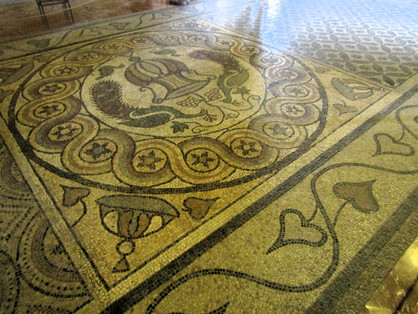The island of Rhodes is the biggest island in the Dodecanese group of islands. It's much closer to Turkey than to mainland Greece.
We headed up to Philermos Hill (Moni Filerimou on the map) from where there is a great view across Rhodes to the sea. The view in one direction includes the airport, and many many planes coming in and out of the island. Around 2.5 million tourists visit Rhodes each year, so it is a popular destination. But it's a relatively large island, so it doesn't seem frenetically busy.
In true Greek style, Philermos Hill has temple upon temple. The ancient Greek temple of Athena Polias was built around 300 BC, over an older one from about 500 BC.
Around 500 AD/CE, a church was built on the ruins of the Athena temple, with the baptistery in the shape of a cross. Four hundred years later, another church was built alongside: the Church of Our Lady of Philermos, dedicated to the Virgin Mary. It houses a 'miracle-making' icon, which I'll come back to.
This intriguing little chapel in the rock was built around the 15th century. The frescoes have survived remarkably well. Gosh, I hear you say. Are those medieval knights on horseback?
And that's my cue for some history. Like all things Greek, Rhodes has a long, fascinating and complicated past.
The Roman empire at its peak consisted of the western and eastern empires. The centre of the western Roman empire was Rome; the centre of the eastern empire was Byzantium, also called Constantinople, now Istanbul. When the western Roman empire fell around 500 AD, the Byzantine empire kept going for another 900 years.
Being in the eastern Aegean Sea, Rhodes was in the Byzantine sphere of influence. Between 1200 and 1300 AD, Rhodes bounced around between rulers: Byzantine rulers, the Turks, splinter Byzantine groups, independent tycoons (seriously) and a Genoese pirate. I am not making this up.
As we all know (thanks to Monty Python, Dan Brown, etc.) the Crusades to the Holy Land were religious wars supported by the Catholic Church, intended to conquer Jerusalem and relieve it from Muslim rule. Plus ça change, plus c'est la même chose. By 1300, these Crusades had come to an end but the 'Crusaders' were still fired up and motivated. The Knights Hospitaller were a Catholic military order (like their rivals the Knights Templar) under the Order of St John. In 1310, the Knights Hospitaller needed a new base. So ... they occupied Rhodes.
The Knights Hospitaller, or Knights of St John, became known as the Knights of Rhodes. They rebult Rhodes — the medieval Old Town — into what they considered was a model of medieval Europe.
Before we get there, though, let's stay with Philermos. The church is famous for housing the miracle-making icon of the Virgin Mary of Philermos. The Knights brought the icon, said to be have been painted by St Luke, with them from Jerusalem, but it was probably made in Constantinople. Of course, this is a copy of the original. I think it's beautiful.
What miracles did it make, I wondered? During a siege by the Turks, 'a pure white dove was seen to rest on the miraculous icon of Our Lady of Philermos; it stayed there for hours; hence the people were given a sign that they would soon be freed from the siege'. The Knights won the battle, so the icon was/is deemed miraculous.*
The Knights also built the Monastery of Philermos. Those are the monks' cells on the ground floor. The monastery was destroyed by the Turks but rebuilt and restored by the Italians when they occupied Rhodes in the 1900s. It's a history book in this one site!
There's one more element to Philermos: the Way of the Cross. The long pathway from the church square heads west to the top of the hill. It's a lovely walk through the avenue of pine trees lined with bronze representations of the Passion of Christ. It was built by the Italians in the 1900s. The view from the cross, across the farmlands to the bay, is stunning.
After a taste of the local monks' liqueur, which was green and heavily botanical, we left Philermos Hill and wound our way past some beaches to the Old Town.
The Medieval City of Rhodes is a UNESCO World Heritage Site and it's absolutely awesome. UNESCO calls the Upper Town 'one of the most beautiful urban ensembles of the Gothic period'. Urban ensemble — I couldn't put it better myself.
The Knights Hospitaller/Knights of Rhodes/Knights of St John built the town into a fortified city able to withstand sieges. There are moats, ramparts, firing posts, curtain walls, parapets with gun holes. Everything that you'd want in a medieval castle!
The Knights (aka ex-Crusaders) came from noble families in Spain, France, England, Germany and Italy, but because this was medieval times and pre-statehood in Europe, there were actually eight 'langues' of Knights, based on geography and language: the Crown of Aragon, the Crown of Castile, Auvergne, Kingdom of England, France, Holy Roman Empire, Italy and Provence. Each langue built their own part of the fortress, and each part is marked with its flag or standard.
It's not just a fortress. There's a palace inside the fortress — the Palace of the Grand Master. The Palace was restored by the Italians in the early 1900s so it has quite a Roman feel. It's now a museum and exhibition space, and it's glorious.
Note the steep marble staircases without handrails. Very un-Australian!
During their renovation, the Italians found the best mosaic floors from the island’s monuments and 'relocated' them to the palace. Not only did they source them from Rhodes, they managed to find quite a few in surrounding islands as well.
This was another place we could have lingered at all day. There are exhibits from early Neolithic times, Minoan, Mycenean, Ancient Greece, the early Christian era ... so many fascinating things left from so many years of cultural and social change.
But out we go into the sunshine of Rhodes Old Town, where tourists are wandering around, shopping, eating and drinking.
And cats, of course. Always cats.

Where are the crowds, you ask? Mainly in the town square, where there are restaurants and bars and coffee shops galore.
Leaving the Old Town by the gate to the sea ... Rhodes, you're a gem.
One last fascinating historical fact. (See, this is what I love about these places.) This was the spot where the Colossus of Rhodes stood, one of the Seven Wonders of the Ancient World. Built around 300 BC, the Colossus was the tallest statue in the ancient world, about the height of the Statue of Liberty. It was toppled by an earthquake about seventy years later and wasn't rebuilt because the Oracle of Delphi warned against it. Must have been a grumpy day up there on Mount Parnassus.
No one really knows what it looked like because it didn't exist for very long. But given the technology of the time, it's most unlikely that it straddled the entrance of the harbour.
One more stop — Bodrum — before we get back to Athens.
* The icon may or may not be miraculous, but it is certainly well travelled. Skipping ahead a few hundred years to 1522, Rhodes was again overtaken by the Turks and the Knights fled with the icon. It was taken to France, Italy, Malta and Russia, where it stayed until the 1917 revolution. The original is now housed in the National Museum of Montenegro. A whole story in itself ...




























































































































Comments